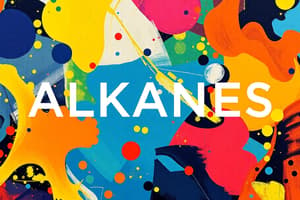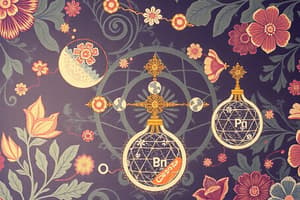Podcast
Questions and Answers
Which of the following alkanes would have the highest boiling point?
Which of the following alkanes would have the highest boiling point?
- CH3CH2CH2CH2CH3 (correct)
- CH3CH2CH3
- CH3CH2CH2CH3
- CH3CH(CH3)CH2CH3
Which of the following statements is true regarding the volatility of alkanes?
Which of the following statements is true regarding the volatility of alkanes?
- Volatility is not affected by branching.
- Volatility increases with increasing molecular size.
- Volatility is not affected by molecular size.
- Volatility decreases with increasing branching. (correct)
Which of the following statements is true regarding the density of alkanes?
Which of the following statements is true regarding the density of alkanes?
- Density is not affected by molecular size.
- Density is not affected by branching.
- Density increases with increasing branching.
- Density decreases with increasing molecular size. (correct)
Which of the following alkanes would be the most volatile?
Which of the following alkanes would be the most volatile?
What products are formed in heterolytic cleavage?
What products are formed in heterolytic cleavage?
Which of the following is a characteristic of homolytic cleavage?
Which of the following is a characteristic of homolytic cleavage?
In the halogenation of methane, what is required for the reaction to occur?
In the halogenation of methane, what is required for the reaction to occur?
What type of species are formed when $CH_3Br$ undergoes heterolytic fission?
What type of species are formed when $CH_3Br$ undergoes heterolytic fission?
What happens to the electron pair in the carbon-bromine bond during homolytic fission?
What happens to the electron pair in the carbon-bromine bond during homolytic fission?
What is the correct order for naming substituents in an organic compound?
What is the correct order for naming substituents in an organic compound?
Which of the following is an example of an inorganic substituent?
Which of the following is an example of an inorganic substituent?
How should the position of a substituent be indicated in an organic compound?
How should the position of a substituent be indicated in an organic compound?
What is the correct IUPAC name for the condensed structure CH3Cl?
What is the correct IUPAC name for the condensed structure CH3Cl?
Which prefix should be used to indicate two identical substituents?
Which prefix should be used to indicate two identical substituents?
What is hybridization in the context of atomic orbitals?
What is hybridization in the context of atomic orbitals?
Why does carbon exhibit a covalency of four despite having only two unpaired electrons?
Why does carbon exhibit a covalency of four despite having only two unpaired electrons?
What type of reactions do alkanes predominantly undergo?
What type of reactions do alkanes predominantly undergo?
What type of bond is formed between carbon atoms in pure alkanes?
What type of bond is formed between carbon atoms in pure alkanes?
Why do alkanes have low reactivity?
Why do alkanes have low reactivity?
In tetrachloromethane (CCl4), how many equivalent carbon-chlorine bonds are formed?
In tetrachloromethane (CCl4), how many equivalent carbon-chlorine bonds are formed?
In the reaction CH₄ + Cl₂ → CH₃Cl + HCl, what type of reaction is taking place?
In the reaction CH₄ + Cl₂ → CH₃Cl + HCl, what type of reaction is taking place?
What is the effect of hybridization on the energy of the orbitals involved in bond formation?
What is the effect of hybridization on the energy of the orbitals involved in bond formation?
Which hydrocarbon has a lower boiling point based on size and volatility?
Which hydrocarbon has a lower boiling point based on size and volatility?
Which of the following statements about the bonds in alkanes is true?
Which of the following statements about the bonds in alkanes is true?
Which type of solvents can alkanes dissolve in?
Which type of solvents can alkanes dissolve in?
What is the physical state of C₁₉ and above alkanes at room temperature?
What is the physical state of C₁₉ and above alkanes at room temperature?
Why are alkanes insoluble in water?
Why are alkanes insoluble in water?
Which of the following statements about the color of alkanes is true?
Which of the following statements about the color of alkanes is true?
In the halogenation of methane, what occurs during the initiation step?
In the halogenation of methane, what occurs during the initiation step?
What products are formed when a chlorine free radical ($Cl$) abstracts a hydrogen atom from methane ($CH_4$) during the propagation step?
What products are formed when a chlorine free radical ($Cl$) abstracts a hydrogen atom from methane ($CH_4$) during the propagation step?
Which of the following correctly describes the role of free radicals in the halogenation of alkanes?
Which of the following correctly describes the role of free radicals in the halogenation of alkanes?
In the termination step of methane halogenation, which of the following reactions leads to the formation of ethane?
In the termination step of methane halogenation, which of the following reactions leads to the formation of ethane?
When methane is in excess during halogenation, what is the major product formed?
When methane is in excess during halogenation, what is the major product formed?
What characterizes an addition reaction?
What characterizes an addition reaction?
Which of the following best describes an elimination reaction?
Which of the following best describes an elimination reaction?
What is the primary result of hydrogenation in organic reactions?
What is the primary result of hydrogenation in organic reactions?
Which reaction process involves the removal of water from a species?
Which reaction process involves the removal of water from a species?
What common chemical process occurs during saponification?
What common chemical process occurs during saponification?
What is the IUPAC name of the compound $CH_3CH(CH_3)CH(Cl)CH(CH_3)CH_2CH_3$?
What is the IUPAC name of the compound $CH_3CH(CH_3)CH(Cl)CH(CH_3)CH_2CH_3$?
What is the correct IUPAC name for the compound $ClCH_2CH_2CH_3$?
What is the correct IUPAC name for the compound $ClCH_2CH_2CH_3$?
What is the IUPAC name of the compound $(CH_3)_2CH(CH_2)_2CH(Br)CH(CH_2CH_3)CH_3$?
What is the IUPAC name of the compound $(CH_3)_2CH(CH_2)_2CH(Br)CH(CH_2CH_3)CH_3$?
What is the IUPAC name of the compound $(CH_3)_3C-C(CH_3)_2CH_2-CH(Cl)CH_3$?
What is the IUPAC name of the compound $(CH_3)_3C-C(CH_3)_2CH_2-CH(Cl)CH_3$?
What is the IUPAC name for the compound $CH_3C(CH_3)_2(CH_2)_3C(CH_3)_3$?
What is the IUPAC name for the compound $CH_3C(CH_3)_2(CH_2)_3C(CH_3)_3$?
What are the two types of substituents in organic compounds?
What are the two types of substituents in organic compounds?
In which order should substituents be listed when naming an alkane with multiple substituents?
In which order should substituents be listed when naming an alkane with multiple substituents?
How should the position of substituents on the parent chain be indicated?
How should the position of substituents on the parent chain be indicated?
What prefix is used to indicate two identical substituents?
What prefix is used to indicate two identical substituents?
How are numbers and names separated in chemical nomenclature?
How are numbers and names separated in chemical nomenclature?
In the compound CH₃Cl, what is the IUPAC name?
In the compound CH₃Cl, what is the IUPAC name?
Why might expanding a condensed structure be necessary?
Why might expanding a condensed structure be necessary?
Flashcards
Inorganic substituents
Inorganic substituents
Substituents that contain atoms other than carbon and hydrogen, such as Cl, Br, I, NH2, NO2, OH, and CN.
Organic Substituents
Organic Substituents
Substituents that consist of alkyl groups, which are chains of carbon and hydrogen atoms. They have the general formula CnH2n-1.
Alphabetical order in naming
Alphabetical order in naming
When naming a compound with multiple substituents, the substituents are listed in alphabetical order.
Least Possible Number
Least Possible Number
Signup and view all the flashcards
Multiple Substituents
Multiple Substituents
Signup and view all the flashcards
What is hybridization?
What is hybridization?
Signup and view all the flashcards
What is a sigma (σ) bond?
What is a sigma (σ) bond?
Signup and view all the flashcards
Why does carbon form four C-Cl bonds in CCl4?
Why does carbon form four C-Cl bonds in CCl4?
Signup and view all the flashcards
How can carbon form 4 bonds when it only has 2 unpaired electrons?
How can carbon form 4 bonds when it only has 2 unpaired electrons?
Signup and view all the flashcards
How are C-C sigma bonds formed in alkanes?
How are C-C sigma bonds formed in alkanes?
Signup and view all the flashcards
What are substituents in organic chemistry?
What are substituents in organic chemistry?
Signup and view all the flashcards
What are inorganic substituents?
What are inorganic substituents?
Signup and view all the flashcards
What are organic substituents?
What are organic substituents?
Signup and view all the flashcards
What is the parent structure in organic nomenclature?
What is the parent structure in organic nomenclature?
Signup and view all the flashcards
How are substituent positions indicated?
How are substituent positions indicated?
Signup and view all the flashcards
How are substituents ordered in IUPAC names?
How are substituents ordered in IUPAC names?
Signup and view all the flashcards
How are multiple occurrences of the same substituent indicated?
How are multiple occurrences of the same substituent indicated?
Signup and view all the flashcards
How is the IUPAC name of an organic molecule formed?
How is the IUPAC name of an organic molecule formed?
Signup and view all the flashcards
IUPAC Naming
IUPAC Naming
Signup and view all the flashcards
Parent Chain
Parent Chain
Signup and view all the flashcards
Substituents
Substituents
Signup and view all the flashcards
Locant
Locant
Signup and view all the flashcards
Alkane
Alkane
Signup and view all the flashcards
Volatility
Volatility
Signup and view all the flashcards
Boiling point trend in alkanes
Boiling point trend in alkanes
Signup and view all the flashcards
Branching and boiling point
Branching and boiling point
Signup and view all the flashcards
Intermolecular forces and volatility
Intermolecular forces and volatility
Signup and view all the flashcards
Branching and volatility
Branching and volatility
Signup and view all the flashcards
Why are alkanes insoluble in water?
Why are alkanes insoluble in water?
Signup and view all the flashcards
Why are alkanes soluble in non-polar solvents?
Why are alkanes soluble in non-polar solvents?
Signup and view all the flashcards
What determines the physical state of an alkane?
What determines the physical state of an alkane?
Signup and view all the flashcards
How does chain length affect boiling point of alkanes?
How does chain length affect boiling point of alkanes?
Signup and view all the flashcards
What is the color of alkanes?
What is the color of alkanes?
Signup and view all the flashcards
Addition Reaction
Addition Reaction
Signup and view all the flashcards
Elimination Reaction
Elimination Reaction
Signup and view all the flashcards
Substitution Reaction
Substitution Reaction
Signup and view all the flashcards
Hydrogenation
Hydrogenation
Signup and view all the flashcards
Dehydration
Dehydration
Signup and view all the flashcards
What is a substitution reaction?
What is a substitution reaction?
Signup and view all the flashcards
Why are alkanes unreactive?
Why are alkanes unreactive?
Signup and view all the flashcards
Which compound will distill off first: heptane or hexane?
Which compound will distill off first: heptane or hexane?
Signup and view all the flashcards
What type of reactions do alkanes undergo?
What type of reactions do alkanes undergo?
Signup and view all the flashcards
What are the other main reactions in organic chemistry?
What are the other main reactions in organic chemistry?
Signup and view all the flashcards
Homolytic cleavage
Homolytic cleavage
Signup and view all the flashcards
Heterolytic cleavage
Heterolytic cleavage
Signup and view all the flashcards
Heterolytic fission
Heterolytic fission
Signup and view all the flashcards
Homolytic fission
Homolytic fission
Signup and view all the flashcards
Covalent bond cleavage
Covalent bond cleavage
Signup and view all the flashcards
Chain Reaction
Chain Reaction
Signup and view all the flashcards
Chain Initiation
Chain Initiation
Signup and view all the flashcards
Chlorine Free Radical
Chlorine Free Radical
Signup and view all the flashcards
Chain Propagation
Chain Propagation
Signup and view all the flashcards
Chain Termination
Chain Termination
Signup and view all the flashcards




